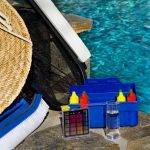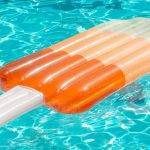This test is the most reliable way to check for the presence of chlorine. If chlorine is present, the sample will turn some color. If it remains clear, there is no chlorine.
- Rinse the chlorine test cell with pool water.
- Fill the chlorine test cell with pool water to the mark.
- Add 5 drops of R-0600.
- Cap the test cell and invert to mix.
- Match the shade/saturation of yellow against the color chart.
- Dispose of the sample safely. It is best to pour it down the drain with the water running. Do not add it back to the pool.
- Rinse the chlorine test cell with tap water and store for next time.
Notes
This test is the most reliable way to check for the presence of chlorine. If chlorine is present, the sample will turn some color. If it remains clear, there is no chlorine.
- This test measures TC, but if you watch closely it is possible to get a sense of the presence of CC. When you first add the drops of R-0600, the sample will immediately show the FC level. Then, over the next minute or so, it will drift up to the TC level. If you see the color changing, CC is present. Using the test in this way requires careful attention and a good ability to distinguish shades of yellow quickly.
- You can use this test to get a vague idea of extremely high TC levels. If the sample turns a particularly vivid yellow the TC level is between 5 and 15, light orange is between 10 and 20, dark orange is between 15 and 30, and brown is 30 or higher.
- If doing the OTO chlorine test and the pH test at the same time, read the pH color first and then chlorine.
- R-0600 is Orthotolidine, a potential carcinogen when ingested.
- The precision of the measurement varies depending on the level being read. At 0.5, or 1 the precision is around +-0.5. At 2 it is around +-1. Above 2 accurate readings become difficult and the precision is very low





